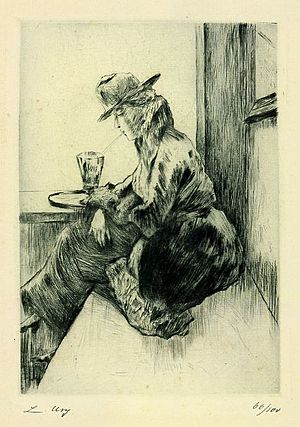Drypoint facts for kids

Drypoint is a special way to make art prints. It's part of a group of printing methods called intaglio. To make a drypoint print, an artist uses a sharp tool, like a needle made of metal or diamond. They use this tool to draw directly onto a flat plate. This plate is often made of copper, but artists also use zinc, acetate, or plexiglas.
When the artist draws on the plate, the sharp needle digs into the material. This creates a groove, but it also pushes up a little ridge of material on the sides of the groove. This ridge is called a "burr." The burr is very important for drypoint prints.
Contents
How Drypoint Works
After the artist draws their picture onto the plate, they prepare it for printing.
- First, ink is spread all over the plate.
- Then, the artist carefully wipes away the extra ink from the flat surface.
- The ink stays trapped in the grooves and under the burrs.
- Next, a piece of paper is placed on top of the inked plate.
- The plate and paper are then put through a special printing press. The press uses a lot of pressure to push the paper into the grooves and against the burrs.
- When the paper is lifted, it pulls the ink from the grooves and burrs, creating the printed image.
The Special Look of Drypoint
The burr is what gives drypoint prints their unique look. When the ink collects under the burr, it creates a soft, slightly fuzzy line in the final print. This is different from other printmaking methods, like engraving, where the lines are usually very sharp and clean. In engraving, the burr is scraped away, but in drypoint, it's kept on purpose.
Drypoint vs. Other Printmaking Methods
Drypoint is often compared to engraving and etching.
- Engraving: In engraving, artists use a tool called a burin to cut deep, clean lines into the plate. The burr is removed.
- Etching: Etching uses acid to create the lines. The artist draws through a protective coating on the plate, and then the plate is put into acid. The acid bites into the exposed metal, creating the lines.
- Drypoint: Drypoint is similar to drawing with a pencil. Artists use a needle to scratch directly onto the plate. Many artists find drypoint easier to learn than engraving because it feels more like drawing.
Materials Used in Drypoint
Artists use different materials for the plates in drypoint.
- Copper: This was the traditional material for drypoint plates. It's still used today.
- Zinc: A common metal plate used in printmaking.
- Acetate: A type of clear plastic.
- Plexiglas: Another type of clear plastic. These plastic plates are often easier to work with for beginners.
Images for kids
-
Mary Cassatt, Woman Bathing, a print made using drypoint and aquatint, 1890–1.
See also
 In Spanish: Grabado a punta seca para niños
In Spanish: Grabado a punta seca para niños



